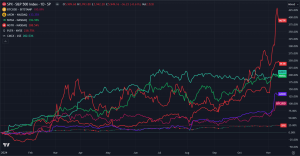I did not know what passive income was when I started investing in shares around 30 years ago. It was only when dividends appeared in my bank account that I understood significant money could be made through little effort.
This regular additional income has given me a much better quality of life than I would have experienced otherwise. It has also allowed me to dramatically reduce my workload since I turned 50 a few years ago.
I hold FTSE 100 global investment manager M&G (LSE: MNG) specifically to make such passive income.
Income star
Last year, the firm paid 19.7p a share in dividends. That gives a yield of 9.5% on the current share price of £2.07. This compares very well to the average FTSE 100 payout of 3.6%.
£9,000 today – the same amount as I started with 30 years ago – invested at 9.5% would make £855 this year. This would mean an extra £8,550 over 10 years if the yield averaged the same.
It is a lot more than would be made in a regular bank account. But even more can be generated by ‘dividend compounding’. In this, the dividends paid are used to buy more of the shares that paid them.
In M&G’s case, doing this would make £14,185 extra after 10 years instead of £8,550.
Thirty years from now, if the yield averaged the same, £144,854 would have been added to the initial £9,000 investment. The £153,854 total investment pot would generate £14,616 in dividends each year!
Can the business support these returns?
M&G’s total shareholder equity is around £4.1bn and its total debt is about £8.1bn. So, its debt-to-equity ratio is just under 2. Many financial services companies use debt to finance their expansion rather than equity as it is cheaper.
However, I would like to see this ratio drop in the next three years to nearer the 1.5 level considered healthy for many companies.
That said, its adjusted operating profit last year jumped by 28% to £797m. It also generated £1.8bn in operating capital, which can be a powerful driver for growth.
How solid does the share price look?
I also look for my passive income-generating shares to be relatively undervalued. This reduces the chances of my dividend payouts being wiped out by big price losses over time.
M&G fits this bill, trading at a price-to-book ratio (P/B) of 1.2 against a peer group average of 3.9.
A discounted cash flow using other analysts’ figures and my own shows the shares to be 47% undervalued at £2.07. Consequently, a fair value for them would be around £3.91.
They could go lower or higher than that, of course. But it signals to me that they are significantly undervalued.
Consequently, if I did not already own M&G shares, I would buy them right now. I think its high yield, growth prospects, and undervaluation are too good to miss out on.
This post was originally published on Motley Fool







